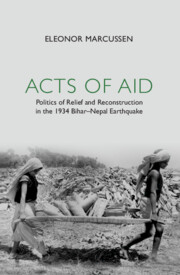Book contents
- Frontmatter
- Contents
- List of Illustrations
- List of Tables
- Acknowledgements
- List of Abbreviations
- Note on Transliteration
- 1 Introduction: Experiencing the Extraordinary and the Ordinary
- 2 Responses and Responsibilities in Emergency Relief
- 3 From Local to National Politics of Relief
- 4 Colonial Relations in Aid
- 5 Categories of Victims
- 6 Congested and Contested Spaces
- 7 Conclusion
- Glossary
- Bibliography
- Index
5 - Categories of Victims
Published online by Cambridge University Press: 13 January 2023
- Frontmatter
- Contents
- List of Illustrations
- List of Tables
- Acknowledgements
- List of Abbreviations
- Note on Transliteration
- 1 Introduction: Experiencing the Extraordinary and the Ordinary
- 2 Responses and Responsibilities in Emergency Relief
- 3 From Local to National Politics of Relief
- 4 Colonial Relations in Aid
- 5 Categories of Victims
- 6 Congested and Contested Spaces
- 7 Conclusion
- Glossary
- Bibliography
- Index
Summary
Introduction: Victimhood
This chapter examines how categories of relief receivers were defined by the government and select relief societies according to the effects of the earthquake, social relations and the political economy of the government. By examining the way categories of relief receivers and damages were defined, the chapter seeks to explore how socio-economic categories and the particular damages of the earthquake intersected and created needs for relief that would come to shape the rehabilitation phase.
After the earthquake, the idea of relief as a compensatory scheme of relative provisions, allocated according to needs based on social and financial class, in many ways bears resemblance to divisions in famine relief. During famines in the nineteenth century, relief societies and the government both allocated and distributed gratuitous relief to categories of relief receivers divided into ‘classes’ defined by social standing and financial losses. The ‘middle classes’ became a class apart among relief receivers as charity and philanthropy were increasingly institutionalised in famine relief. Labourers and the so-called able-bodied carried out ‘works of public utility’, for instance, on the notorious famine works, while the rest were left to charity of the public and private kind. The government’s definition of ‘able-bodied’ was not uniform, as in the case of the 1892 Orissa famine when the local government classified workers according to skills, physical abilities and whether or not they were considered accustomed to hard labour.
Famine relief by the colonial state divided people according to who were ‘the deserving and the undeserving’, according to Sanjay Sharma: ‘By introducing new measures of need, by attempting to distinguish between ordinary beggary and crisis-destitution, and by exacting work in return for relief to prevent indolence, the colonial state set the parameters in which new notions of the deserving and the undeserving crystallized over a period of time.’ In the context of the eighteenth-century Madras Presidency, Ravi Ahuja has noted how famine relief classification detailed subsistence and means for survival. The colonial administrators allotted a right of subsistence unevenly to different groups by giving preferential treatment to house-owners, occupational groups of strategic value, ‘poor Europeans’, so-called Eurasians and sepoys and ‘possibly’ Brahmins. Later policy documents such as the Bengal Famine Manual from 1941 continued the tradition of needs-based relief with stratification of relief according to class and physical abilities.
- Type
- Chapter
- Information
- Acts of AidPolitics of Relief and Reconstruction in the 1934 Bihar–Nepal Earthquake, pp. 192 - 247Publisher: Cambridge University PressPrint publication year: 2023
- Creative Commons
- This content is Open Access and distributed under the terms of the Creative Commons Attribution licence CC-BY-NC 4.0 https://creativecommons.org/cclicenses/



